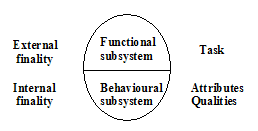Systemion Model
Two significant features distinguish traditional software agents from the entities studied by the various systemic theories:
- Opening: these entities are opened to the external world, i.e. they are able to physically exchange items of various natures with the environment.
- Transformation: they implement structuring and unstructuring internal mechanisms without their interactions causing the entity to stop.
In order to study in a uniform way phenomena and systems lending themselves to a systemic analysis, Jean-Louis Le Moigne proposed the General Object concept defined as something:
- Which is identifiable
- Which does something, i.e. has a function
- And which, provided with a structure,
- Evolves during time
- Into something (environment)
- For something (finality).
We adapted the General Object concept to the software agent context in order to be able to modelise and to implement complex properties of the agents, some already explored in the MAS field (ex: autonomy), others little or not studied (ex: natural finality).
The Systemion Model (SYSTEMIc daemON) is an architecture model of a software agent which combines and articulates into a unique framework the concepts of General Object, internal finality and external finality, qualities, attributes and tasks. This software architecture can be split up into two subsystems:
- A functional subsystem which materializes the external finality, i.e. properties related to the fulfilment of the task possibly assigned to the agent.
- A behavioural subsystem: it contains the properties (qualities and attributes) specific to the agent, i.e. the properties which are independent from the task which it will have to execute. This software layer implements the internal finality.

Systemion Architecture
A systemion is a software agent built according to the Systemion Model.
The Systemion Model was used to analyze various classes of software entities such as worms, viruses and software daemons. It made it possible to define new classes of software agents (empty, unitask or pluritask agent), to propose new properties (ex: the modification attribute) and to interpret in a new manner the concept of opening.





 +33 (0)5.65.77.10.80
+33 (0)5.65.77.10.80
